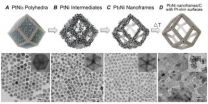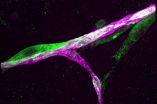(Press-News.org) New research by UC Santa Barbara's Kenneth S. Kosik, Harriman Professor of Neuroscience, reveals some very unique evolutionary innovations in the primate brain.
In a study published online today in the journal Neuron, Kosik and colleagues describe the role of microRNAs — so named because they contain only 22 nucleotides — in a portion of the brain called the outer subventricular zone (OSVZ). These microRNAs belong to a special category of noncoding genes, which prevent the formation of proteins.
"It's microRNAs that provide the wiring diagram, dictating which genes are turned on, when they're turned on and where they're turned on," said Kosik, who is also the co-director of UCSB's Neuroscience Research Institute and a professor in the Department of Molecular, Cellular and Developmental Biology. "There's a core set with which all kinds of really complex things can be built, and these noncoding genes know how to put it together."
The researchers were looking for these noncoding genes, Kosik continued, because as organisms become more complex through evolution, the number of these noncoding genes has greatly expanded. "But the coding genes — the ones that make proteins — have really not changed very much," he said. "The action has been in this noncoding area and what that part of the genome is doing is controlling the genes."
Many of the microRNAs that Kosik's team found and subsequently sequenced are newly evolved in primates. The work showed that these tiny control elements were overrepresented in the OSVZ of the developing macaque brain tissues they analyzed. The tissue samples were provided by a lab at the Stem-cell and Brain Research Institute near Lyon, France, headed by research director and co-author Colette Dehay.
Study results indicate that the appearance of the OSVZ is very much associated with the invention of new microRNAs. "There might be some relationship — although we can't prove it — between the invention of some of these new noncoding genes, microRNAs, and the appearance of a new structure, the OSVZ," Kosik said. "Trying to connect an anatomical, morphological invention with genes is very difficult, but our work shows a possible molecular basis for the tools that were needed to build this novel structure."
The analysis found that these new microRNAs target old genes, many involved in the cell cycle, which is responsible for cell division (mitosis). "Nearly all cells throughout evolution have a cell cycle," Kosik explained. "We can watch the evolutionary process at a very molecular level, see what is novel and how molecular innovation affects what already exists, like the cell cycle. When new things are invented in evolution, they have to be integrated with what already exists.
"What I find fascinating is that the whole ancient cellular mechanism of cell division still has enough evolutionary space left to make something new and to make something new that's really complex," he added. "The OSVZ gave rise to primates' expanded brains and to the cells that ultimately brought us Shakespeare."
According to Kosik, the microRNAs he studied are a melding of molecular and anatomical information. "Some of the genes we found that are the targets of these new microRNAs are also involved in certain human developmental disorders that are genetic," he said.
"One place we would like to go with this information is to explore pathways that may be manipulated to help patients in some way," he said. "We know people with developmental disorders may be missing a critical gene involved in brain formation and wiring, so maybe if we understood the control of those genes — as these new data are pointing to — we might be able to do something that could be applied to a human condition."
INFORMATION: END
UCSB study reveals evolution at work
Analyses conducted at UCSB elucidate a part of the brain particular to primates
2014-02-27
ELSE PRESS RELEASES FROM THIS DATE:
Big step for next-generation fuel cells and electrolyzers
2014-02-27
A big step in the development of next-generation fuel cells and water-alkali electrolyzers has been achieved with the discovery of a new class of bimetallic nanocatalysts that are an order of magnitude higher in activity than the target set by the U.S. Department of Energy (DOE) for 2017. The new catalysts, hollow polyhedral nanoframes of platinum and nickel, feature a three-dimensional catalytic surface activity that makes them significantly more efficient and far less expensive than the best platinum catalysts used in today's fuel cells and alkaline electrolyzers. This ...
Fossilized human feces from 14th century contain antibiotic resistance genes
2014-02-27
A team of French investigators has discovered viruses containing genes for antibiotic resistance in a fossilized fecal sample from 14th century Belgium, long before antibiotics were used in medicine. They publish their findings ahead of print in the journal Applied and Environmental Microbiology.
"This is the first paper to analyze an ancient DNA viral metagenome," says Rebecca Vega Thurber of Oregon State University, Corvallis, who was not involved in the research.
The viruses in the fecal sample are phages, which are viruses that infect bacteria, rather than infecting ...
Physicians' stethoscopes more contaminated than palms of their hands
2014-02-27
VIDEO:
A comparative analysis shows that stethoscope diaphragms are more contaminated than the physician's own thenar eminence (group of muscles in the palm of the hand) following a physical examination.
Click here for more information.
Rochester, MN, February 27, 2014 – Although healthcare workers' hands are the main source of bacterial transmission in hospitals, physicians' stethoscopes appear to play a role. To explore this question, investigators at the University of ...
Study reveals mechanisms cancer cells use to establish metastatic brain tumors
2014-02-27
NEW YORK, NY, February 27, 2014 — New research from Memorial Sloan Kettering provides fresh insight into the biologic mechanisms that individual cancer cells use to metastasize to the brain. Published in the February 27 issue of Cell, the study found that tumor cells that reach the brain — and successfully grow into new tumors — hug capillaries and express specific proteins that overcome the brain's natural defense against metastatic invasion.
Metastasis, the process that allows some cancer cells to break off from their tumor of origin and take root in a different tissue, ...
Methane leaks from palm oil wastewater are a climate concern, CU-Boulder study says
2014-02-27
In recent years, palm oil production has come under fire from environmentalists concerned about the deforestation of land in the tropics to make way for new palm plantations. Now there is a new reason to be concerned about palm oil's environmental impact, according to researchers at the University of Colorado Boulder.
An analysis published Feb. 26 in the journal Nature Climate Change shows that the wastewater produced during the processing of palm oil is a significant source of heat-trapping methane in the atmosphere. But the researchers also present a possible solution: ...
Famed Milwaukee County Zoo orangutan's death caused by strange infection
2014-02-27
MADISON – Mahal, the young orangutan who became a star of the Milwaukee County Zoo and an emblem of survival for a dwindling species, led an extraordinary life.
It turns out, the young ape died an extraordinary death, too.
Rejected by his biological mother at the Cheyenne Mountain Zoo in Colorado Springs, Colo., and eventually flown to Milwaukee aboard a private jet to live with a surrogate mother, Mahal became one of the Milwaukee County Zoo's star attractions. His unexpected death at age 5 in late December 2012 was a shock to the community that came to know him through ...
Scientists describe deadly immune 'storm' caused by emergent flu infections
2014-02-27
LA JOLLA, CA—February 26, 2014—Scientists at The Scripps Research Institute (TSRI) have mapped key elements of a severe immune overreaction—a "cytokine storm"—that can both sicken and kill patients who are infected with certain strains of flu virus.
Their findings, published in this week's online Early Edition of the Proceedings of the National Academy of Sciences, also clarify the workings of a potent new class of anti-inflammatory compounds that prevent this immune overreaction in animal models.
"We show that with this type of drug, we can quiet the storm enough to ...
Livestock found ganging up on pandas at the bamboo buffet
2014-02-27
VIDEO:
A panda in the Wolong Nature Reserve munches on bamboo -- which comprises 99 percent of the endangered species' diet in the wild.
Click here for more information.
Pandas, it turns out, aren't celebrating the Year of the Horse.
Livestock, particularly horses, have been identified as a significant threat to panda survival. The reason: They're beating the pandas to the bamboo buffet. A paper by Michigan State University panda habitat experts published in this week's Journal ...
Making treatment of rare blood disorder more affordable and effective
2014-02-27
PHILADELPHIA — A University of Pennsylvania research team has defined a possible new way to fight a disease that is currently treatable only with the most expensive drug available for sale in the United States. In a study published this month in Blood, the Penn team describes the strategy, based on the oldest part of the human immune system – called "complement" -- that could turn out to be less costly and more effective for the majority of patients with a rare blood disorder.
Complement is a network of more than 50 proteins in the blood and on cell surfaces that quietly ...
International study shows majority of children unaware of cigarette warning labels
2014-02-27
College Park, Md. -- An international study of children's perceptions of cigarette package warning labels found that the majority of children are unaware that they exist. Children in countries where larger warning labels are used, and which include a compelling graphic image of the negative health impacts of smoking, were more likely to be aware of and understand the health risks of tobacco products.
The study, led by Dina Borzekowski, Ed.D, in the University of Maryland School of Public Health (UMD SPH), and Joanna Cohen, PhD, Johns Hopkins Bloomberg School of Public ...
LAST 30 PRESS RELEASES:
Making lighter work of calculating fluid and heat flow
Normalizing blood sugar can halve heart attack risk
Lowering blood sugar cuts heart attack risk in people with prediabetes
Study links genetic variants to risk of blinding eye disease in premature infants
Non-opioid ‘pain sponge’ therapy halts cartilage degeneration and relieves chronic pain
AI can pick up cultural values by mimicking how kids learn
China’s ecological redlines offer fast track to 30 x 30 global conservation goal
Invisible indoor threats: emerging household contaminants and their growing risks to human health
Adding antibody treatment to chemo boosts outcomes for children with rare cancer
Germline pathogenic variants among women without a history of breast cancer
Tanning beds triple melanoma risk, potentially causing broad DNA damage
Unique bond identified as key to viral infection speed
Indoor tanning makes youthful skin much older on a genetic level
Mouse model sheds new light on the causes and potential solutions to human GI problems linked to muscular dystrophy
The Journal of Nuclear Medicine ahead-of-print tip sheet: December 12, 2025
Smarter tools for peering into the microscopic world
Applications open for funding to conduct research in the Kinsey Institute archives
Global measure underestimates the severity of food insecurity
Child survivors of critical illness are missing out on timely follow up care
Risk-based vs annual breast cancer screening / the WISDOM randomized clinical trial
University of Toronto launches Electric Vehicle Innovation Ontario to accelerate advanced EV technologies and build Canada’s innovation advantage
Early relapse predicts poor outcomes in aggressive blood cancer
American College of Lifestyle Medicine applauds two CMS models aligned with lifestyle medicine practice and reimbursement
Clinical trial finds cannabis use not a barrier to quitting nicotine vaping
Supplemental nutrition assistance program policies and food insecurity
Switching immune cells to “night mode” could limit damage after a heart attack, study suggests
URI-based Global RIghts Project report spotlights continued troubling trends in worldwide inhumane treatment
Neutrophils are less aggressive at night, explaining why nighttime heart attacks cause less damage than daytime events
Menopausal hormone therapy may not pose breast cancer risk for women with BRCA mutations
Mobile health tool may improve quality of life for adolescent and young adult breast cancer survivors
[Press-News.org] UCSB study reveals evolution at workAnalyses conducted at UCSB elucidate a part of the brain particular to primates






